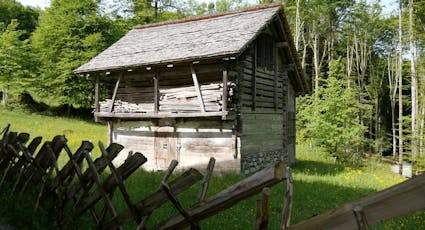723 – Hay Barn from Spiringen UR, 19th Century
This tightly framed stall in block timber construction stands on a quarrystone foundation. The wall timbers of the barn in the upper storey are spaced apart to allow air to circulate in the hay.

Typical Structure
This tightly framed stall in block timber construction stands on a quarrystone foundation. The wall timbers of the barn in the upper storey are spaced apart to allow air to circulate in the hay as in the barn from Sachseln (712). Unspectacular in form and size and devoid of decoration, this field barn is typical not only for the Schächen valley: one encounters them by the thousand in Central Switzerland.

Relay Station
Field barns served alpine staged farming: in the rhythm of the seasons farmers pastured their livestock at varying elevations, letting them graze the meadows in spring and autumn and feeding them hay from the valley in winter. The barn from Spiringen is such a field stall.
Fading Demand
This stall, however, stood in the village and was the property of the “Post” inn. It was by no means the main barn. The penultimate lessee, Victor Herger, kept 3 cows and 5 or 6 calves there in the 1950’s. The final lessee, the factory hand Benjamin Schuler, kept 5 to 7 goats and a few sheep there. In 1984 it was dismantled to make way for a roadway correction.
“Factory Farmers”
Between the 1950’s and 1970’s great economic and social changes swept the alpine region. Many farmers sold their heifers and cows in order to go to work in a factory. They became sideline farmers and changed to the less demanding husbandry of small livestock: goats and sheep that they could tend in their spare time on the farmland inherited from their parents.
What can you see now in Spiringen where this hay barn used to stand?
Where hay once lay waiting to be used as cattle fodder, now mountaineers wait for the cable car.
Ballenberg
Swiss Open-Air Museum
Museumsstrasse 100
CH-3858 Hofstetten bei Brienz
Company holidays
24 December 2025 to 11 January 2026
Opening hours Administration
3 November 2025 to 8 April 2026
From Monday to Friday
8.30 am to 11.30 am
1.30 pm to 4.30 pm
Opening hours
9 April to 1 November 2026
10 am to 5 pm daily